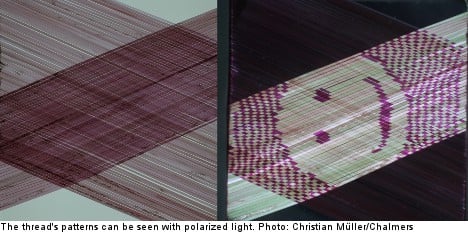The thread, produced in the lab by Chalmers researcher Christian Müller, has unique optical properties that can be used to create patterns invisible to the naked eye, but which can be seen under polarized light.
“I made the discovery in conjunction with a rather fundamental study looking at the optical properties of different polymers,” Müller told The Local.
“I found that, by weaving the threads I could create different, unique patterns.”
He explained that clothing manufacturers could start using the thread right away to put a signature pattern in their products.
“The production process itself is very simply,” he said.
Müller created the thread using polyethylene and a dye molecule that absorbs visible light. The thread can be weaved into a pattern that can only be seen when viewed under polarized light.
The thread can be made using synthetic textile such as nylon, but the dye molecule can also be bonded to natural fibres such as wool and silk.
The new thread can help fashion houses and clothing manufacturers protect against textile pirating by creating their own combination of fibres and dye molecules.
“It is very difficult for pirate manufacturers to copy the unique combination,” Müller explained, adding there are “loads” of different dye molecules available.
“They can obtain the equipment needed to read the pattern and ascertain the optical spectrum produced by a specific signature, but they cannot know which combination of components will produce the specific spectrum.”
Use of the new “invisible thread” can extend beyond the fashion industry and into specialty fabrics used in vehicles, but textile manufactures from around the world have already been in touch with Müller about his discovery, which was first outlined in a study published in August 2012 in Applied Physics Letters, the journal of the American Institute of Physics.
“The clothes we wear are actually only a small fraction of the textile industry,” he said.
“If you are purchasing huge quantities of specialty fabric for Volvo, for example, you want to be sure you are getting the real thing.”
The new thread could aid customs officials in their hunt for counterfeit goods by making it easier to tell the difference between knockoffs and the genuine article.
Müller’s discovery could also be used to manufacture “smart textiles” of other sorts such as clothing that can change colour based on an electrical charge.
Another application could be weaving a “virtual bar code” into fabrics that would allow suppliers to track inventory and ensure quality control.
“Once I find the right partner, I’d estimate we could be on the market within six months,” Müller told The Local
David Landes




 Please whitelist us to continue reading.
Please whitelist us to continue reading.
Member comments